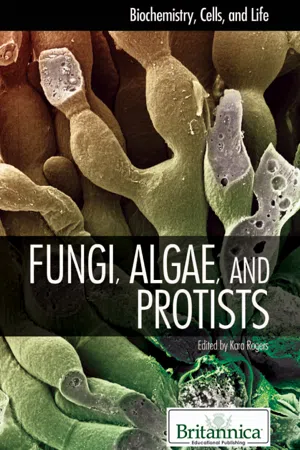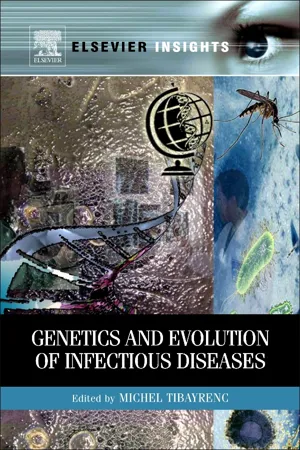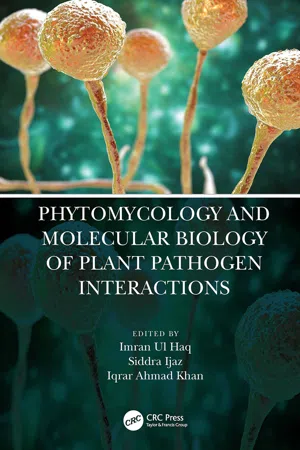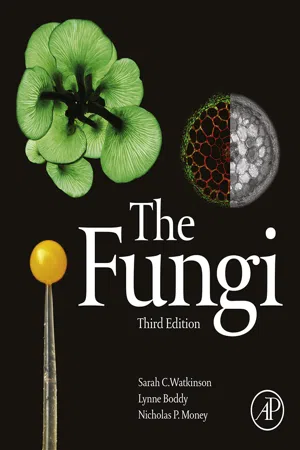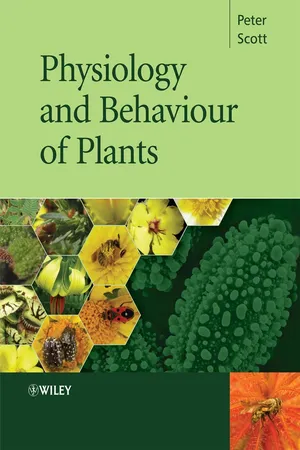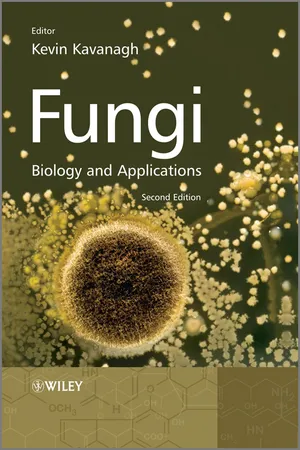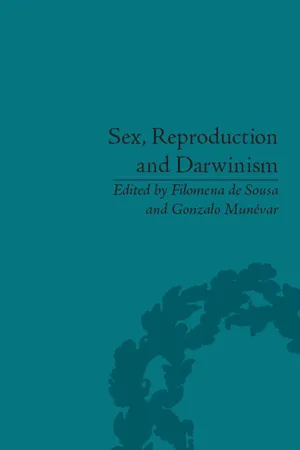Biological Sciences
Fungal Asexual Reproduction
Fungal asexual reproduction is a process in which fungi produce offspring without the involvement of sexual reproduction. This can occur through various methods such as fragmentation, budding, or the formation of spores. Asexual reproduction allows fungi to rapidly increase their population and is an important mechanism for their survival and dispersal.
Written by Perlego with AI-assistance
Related key terms
9 Key excerpts on "Fungal Asexual Reproduction"
- eBook - ePub
- Britannica Educational Publishing, Kara Rogers(Authors)
- 2010(Publication Date)
- Britannica Educational Publishing(Publisher)
Typically in asexual reproduction, a single individual gives rise to a genetic duplicate of the progenitor without a genetic contribution from another individual. Perhaps the simplest method of reproduction of fungi is by fragmentation of the thallus, the body of a fungus. Some yeasts, which are single-celled fungi, reproduce by simple cell division, or fission, in which one cell undergoes nuclear division and splits into two daughter cells. After some growth, these cells divide, and eventually a population of cells forms. In filamentous fungi the mycelium may fragment into a number of segments, each of which is capable of growing into a new individual. In the laboratory, fungi are commonly propagated on a layer of solid nutrient agar inoculated either with spores or with fragments of mycelium.Budding, which is another method of asexual reproduction, occurs in most yeasts and in some filamentous fungi. In this process, a bud develops on the surface of either the yeast cell or the hypha, with the cytoplasm of the bud being continuous with that of the parent cell. The nucleus of the parent cell then divides. One of the daughter nuclei migrates into the bud, and the other remains in the parent cell. The parent cell is capable of producing many buds over its surface by continuous synthesis of cytoplasm and repeated nuclear divisions. After a bud develops to a certain point and even before it is severed from the parent cell, it is itself capable of budding by the same process. In this way, a chain of cells may be produced. Eventually, the individual buds pinch off the parent cell and become individual yeast cells. Buds that are pinched off a hypha of a filamentous fungus behave as spores; that is, they germinate, each giving rise to a structure called a germ tube, which develops into a new hypha.Although fragmentation, fission, and budding are methods of asexual reproduction in a number of fungi, the majority reproduce asexually by the formation of spores. Spores that are produced asexually are often termed mitospores, and such spores are produced in a variety of ways. - eBook - ePub
- Michel Tibayrenc(Author)
- 2010(Publication Date)
- Elsevier(Publisher)
4.7.1. Reproductive SystemFungi present a striking diversity of life cycles, and studying their reproductive biology is a challenging task. However, this information is critical to assess the risk posed by pathogens and for the design of disease management strategies ( McDonald and Linde, 2002 ). For instance, outcrossing promotes genetic exchange and can accelerate the spread of new mutations in combination with other beneficial alleles, which is critical in the context of an arms race between hosts (or the humans that breed or grow them) and pathogens. By contrast, selfing or asexual reproduction provides insurance of reproduction for species having a low probability of finding a mate, and these species can therefore invade distant territories more easily and/or more rapidly ( Taylor et al., 2006 ). Asexual reproduction is also an expeditious way of multiplying rapidly favorable combinations of genes built by past selection ( Otto, 2009 ) and a more efficient strategy of transmitting genes to the next generation. Indeed, an asexual parent transmits 100% of its genes to the next generation, against only 50% for a sexual parent, which is called “the twofold cost of sex” in anisogamous species ( Bell, 1982 ). In the following, we briefly define the terminology used to qualify different aspects of fungal reproductive systems, and then we provide an overview of the methods available for their analysis, with some case studies among the fungal pathogens.TerminologyInconsistent use of key terms might be a cause of the slow integration of fungi in the field of evolution, and more generally unclear definitions of concepts are often an obstacle in the progress of science ( Neal and Anderson, 2005 ). A proper identification of the key features of the reproductive system of fungal pathogens is also fundamental for the correct selections of appropriate models to study population structure ( Giraud et al., 2008a - Imran Ul Haq, Siddra Ijaz, Iqrar Ahmad Khan, Imran Ul Haq, Siddra Ijaz, Iqrar Ahmad Khan(Authors)
- 2022(Publication Date)
- CRC Press(Publisher)
Mishra, 1977 ). Changes in the composition of the cell wall can change many functions, such as cause polarized growth patterns (Valentine and Bainbridge, 1978).Reproduction
Reproduction of fungi is the biological process through which new fungal organisms are formed from parents. Reproduction is a fundamental feature of all living organisms. There are three main methods of reproduction in fungi:- Sexual
- Vegetative
- Asexual
Vegetative Mode of Reproduction
Vegetative reproduction of fungi involves the somatic portion of the thallus, in which new fungal organisms are formed, exclusive of seeds and spores, by syngamy or meiosis. Vegetative reproduction can occur by the following methods:- Fragmentation
- Budding
- Fission
- Rhizomorphs
- Oidia
- Sclerotia
- Chlamydospores
Fragmentation
The mycelium converts into small bits by accident, mechanical injury, or several hyphal segments in this method. Each segment develops into new hyphae under suitable conditions on the further division of fungal cells.Budding
The budding method of reproduction occurs mainly in yeast cells. In budding, a small outgrowth, called “bud,” comes from the parent cell. The bud enlarges and is separated by cross wall formation from the mother cell. This detached portion of the cell develops into new, independent yeast. Occasionally, a budding chain is produced when the first bud does not get separated from the parent cell.Fission
Some fungi reproduce when a single fungal cell multiplies by fission, in which the mother cell becomes elongated and divides transversely into two daughter cells of the fungus. In this method, first the nucleus divides, then the cytoplasm, and finally the cell wall is formatted. The two new cells then become independent.Rhizornorphs
In higher fungi, sometimes hyphae exist in rope-like structures known as rhizomorphs. When conditions become favorable, these rhizomorphs grow and give rise to new mycelia and fruiting bodies. Rhizomorphs remain dormant under unfavorable conditions. These dark brown rhizomorphs are rope-like structures.- eBook - ePub
- Stuart Hogg(Author)
- 2013(Publication Date)
- Wiley-Blackwell(Publisher)
Figure 8.3 ). The conidia may be naked or protected by a flask-like structure called the pycnidium. Asexual reproduction by conidia formation is a means of rapid propagation for the fungus in favourable conditions. The characteristic green, pink or brown colour of many moulds is due to the pigmentation of the conidia, which are produced in huge numbers and dispersed by air or water currents. The conidia germinate to form another haploid mycelium.Figure 8.3 Asexual reproduction in the Ascomycota. Chains of conidia develop at the end of specialised hyphae called conidiophores.Figure 8.4 Budding in yeasts. Yeast cells in various stages of budding. A protuberance or bud develops on the parent yeast; the nucleus undergoes division and one copy passes into the bud. Eventually the bud is walled off and separated to form a new cell.In the case of the unicellular yeasts, asexual reproduction occurs as the result of budding , a pinching off of a protuberance from the cell, which eventually grows to full size (Figure 8.4 ).Plasmogamy is the fusion of the cytoplasmic content of two cells. Karyogamy is the fusion of nuclei from two different cells.Although some ascomycetes are self-fertile, sexual reproduction often involves separate ‘plus’ and ‘minus’ mating strains. Reproductively distinct, these two types are, however, morphologically identical, so it is not appropriate to refer to them as ‘male’ and ‘female’. The hyphae involved in reproduction are termed the antheridium (+ strain) and ascogonium (− strain). Hyphae from the different strains grow together and there is a fusion of their cytoplasm (Figure 8.5 - eBook - ePub
- Sarah C. Watkinson, Lynne Boddy, Nicholas Money(Authors)
- 2015(Publication Date)
- Academic Press(Publisher)
Aspergillus species hitherto considered to be asexual, whole genome sequences have revealed the presence of suites of genes associated with parts of the sexual cycle in other ascomycetes, including for mating and pheromone response, meiosis, and development of fruit bodies. Population genetic studies have also shown evidence of genetic recombination (linkage disequilibrium) which indicates past sexual activity.Many plant and animal pathogens are considered to be asexual, but this is likely due to the fact that only one clone has the set of genes needed to infect the appropriate plant or animal. Although Magnaporthe oryzae is, for example, considered to have an asexual life cycle, there appears to be a sexual population in India, and the global distribution of clones and clonal lineages probably reflects rare ‘escapes’ from the sexual population. The human pathogen Candida albicans was, until recently, thought to be completely asexual, always being diploid, however, mating between cells with opposite mating types (see below) does occur. However, as well as this heterothallism (see below), homothallism also occurs.Mating Systems
Fungi have mating systems or breeding systems that determine whether or not individuals of the same species can mate. Some fungi are self-fertile but many fungi have genetic systems that prevent mating between very genetically similar individuals, (i.e. self-sterile) so that genetic diversity will be increased. With basidiomycetes, since somatic (vegetative) incompatibility (pp. 102–104) often prevents non-self mycelium from fusing to form a stable connection containing nuclei from both, this rejection mechanism has to be overcome before successful mating can occur. With ascomycetes, somatic (vegetative) incompatibility is suppressed during mating, provided that mating occurs between female reproductive structures (protoperithecia) and a male cell, and does not require hyphal fusion (heterokaryon formation) prior to perithecia formation. Compatible matings are determined by mating-type (MAT) factors. The MAT loci have a complex genetic structure. In Coprinus cinereus , for example, there are four sites each having two closely linked loci with multiple alleles. However, in population genetics, these complex loci can usually be treated as if they were simply multiple alleles at two loci, A and B, i.e. A1 …An and B1 …Bn , or in the case of some basidiomycetes one locus A1 …An - eBook - ePub
- Peter Scott(Author)
- 2013(Publication Date)
- Wiley-Interscience(Publisher)
Longevity . Plants may, in many instances, be long-suffering and long-lasting, but if the great extinctions of the past teach us anything, it is that nothing lasts forever. No matter how old an individual plant is, one day conditions will change to make survival impossible. Plants need some means of surviving such adverse conditions, which may be local or temporary, and reproduction can offer a solution to this. Clonal plants may move away from the point of origin of the mother plant and therefore widen the spread of the plant, thereby escaping a particular stress. In addition, seeds offer even greater opportunities to disperse genetic material well away from the parent plant and also provide a structure that can remain dormant over prolonged periods. This permits a plant to survive temporary changes in conditions. Clones or seeds also produce new individuals which are free from fungal infections or damage present in the parent plant.3. Genetic variation . Finally, reproduction offers opportunities for genetic variation, which is essential in a changing habitat. Asexual reproduction offers little opportunity for genetic variation but the potential from sexual reproduction is immense.In this chapter we will look in greater detail at how plants reproduce and the merits and limitations of the different methods.Asexual reproduction
Many plant species use asexual reproduction as a means of propagation. Asexual reproduction has several advantages and disadvantages (Figure 9.1 ). This form of reproduction produces individuals that are genetically identical and does not support much scope for phenotypic variation. This can lead to plants being vulnerable to changes in the habitat. In addition, offspring are generated close to the parent plant, so parent and offspring often have to compete for nutrients and light. However, asexually produced plants usually attain adulthood in advance of seedlings of the same parent and hence rapidly out-compete neighbouring plants reliant on seeds. Under many conditions, asexual reproduction is more successful than sexual reproduction for plants and a large number of species use this as their sole means of reproduction.Figure 9.1 Asexual reproduction in plants. Plants possess a range of different means of asexual reproduction. (A) Apomixis: using this method, the flowers spontaneously produce seeds without the need for any fertilization. The actual source of the embryo can come from the egg cell or the cells surrounding it. (B) A hyacinth bulb (Hyacinthus hybrid); bulbs frequently produce bulbils (small offset bulbs) at the base of the bulb. (C) A gladiolus corm (Gladiolus hybrid); corms frequently produce small offset corms at the base of the stem. (D) Strawberry plant (Fraxinus hybrid), forming runners, modified stems that form new plants. (E) Black poplar (Populus nigra - eBook - ePub
Fungi
Biology and Applications
- Kevin Kavanagh(Author)
- 2011(Publication Date)
- Wiley(Publisher)
Figure 2.5 ), vegetative growth occurs via budding yeast. Sexual reproduction involves the differentiation of yeast cells into hyphae upon exposure to pheromone, resulting in dikaryotic hyphae. Basidia differentiate from the ends of the hyphae, in which karyogamy followed by meiosis and mitosis occurs, producing haploid basidiospores. Upon release, the spores grow as budding yeast. The yeast cells can also undergo asexual sporulation in response to nitrogen limitation or desiccation. Under these conditions, yeast cells differentiate into hyphae, which differentiate monokaryotic basidia at their tips. Mitosis occurs within the basidia, producing haploid spores, which then germinate into yeast cells.Filamentous fungi exhibit many variations in their lifecycles, and some do not exhibit a known sexual phase (the Deuteromycetes). Others exploit parts of the life cycle for pathogenesis, particularly in the pathogenic basidiomycetes. For example, the dimorphic corn smut fungus Ustilago maydis exists as a nonpathogenic yeast form, but upon mating the yeast cells differentiate into dikaryotic hyphae, which are associated with virulence.2.3 Sexual Analysis: Regulation of Mating 2.3.1 Ascomycete YeastThe yeast S. cerevisiae has a simple mating system, with cells of two haploid mating types termed a and α. These cells can conjugate to form a diploid cell containing both a and α information. The a /α diploid is not capable of mating but can initiate meiosis to form four haploid products, two of which are mating-type a and two of which are mating-type α. Laboratory strains typically have stable mating types and are termed heterothallic. In contrast, most wild strains are homothallic and do not have stable mating types. Instead, during mitotic growth, the cells are capable of switching their mating types; thus, a growing spore colony develops cells of both a and α. These cells mate with each other, resulting in a colony that grows up as an a /α diploid. The regulation of the stability of the mating type is controlled by a single locus, termed the homothallism locus (HO ). The HO locus contains a functional endonuclease, whereas the stable mating types of the heterothallic strains result from a defective allele of this locus, designated ho - T. J. Pandian(Author)
- 2023(Publication Date)
- CRC Press(Publisher)
Fig. 7.3 D, E).Figure 7.3 Modes of fertilization in fungi. Note: the gametangia serve as ‘gametes’ in (D, E) zygomytcotes and some (G) ascomycotes (modified and redrawn from onlinebiologynotes.com).Somatogamy: The fusion between ‘vegetative’ gametes, which are not morphologically different from the vegetative body. These gametes may be single-celled motile zoospores (e.g., Polyphagus macrogynus, Fig. 7.3A , B) or immotile yeasts (Fig. 7.3 F) or even multicellular hyphae (Fig. 7.3 D, E).Gamete fusion: The fusion between iso- or aniso-gamic gametes arising from the oogonium and antheridium to form an oospore. They may be motile (e.g., chytrids) or immotile (e.g., Agaricales). In most cases, anisogamy leads to oogamy (Fig. 7.3 C).Spermatization: Penetration and fusion of antheridial nucleus with larger immotile oogonium to form oospores, after the development of the fertilization tube and its chemotropic growth, e.g., Ascomycota (Fig. 7.3 G). In contrast, the trichogyne curves to receive ‘male’ gamete in Neurospora (Fig. 7.3 H).Sexual reproduction in fungi occurs in temporally separated three stages (see p 34 ). Firstly, plasmogamy involves the cytoplasmic fusion between compatible mating types. It is followed by karyogamy, in which the two haploid nuclei fuse. Finally, meiosis takes place to restore haploidy from the newly produced diploid status. The interval between plasmogamy and karyogamy may last for hours or days. Rarely, a few basidiomycotes may not encounter compatible mycelium for many weeks (wk) or years; for example, Trametes versicolor persist as monokaryon for several years in nature (see Watkinson et al., 2015 ).The modes of fusion can be looked at from different points of view: (i) cellular (e.g., yeast conjugation in Pucciniales) vs. hyphal conjugation (e.g., Zygomycota). (ii) motile zoospores (e.g., chytrids, oomycotes) vs. immotile gametes/hyphae. (iii) fusion between iso- (e.g., Physarum polycephalum) and aniso-gamy (e.g., Polyphagus euglenae) and (iv) oogamic fusion. Another mode of grouping is (i) motile complementary mating types that move toward each other (e.g., P. euglenae), (ii) multicellular hyphae that are pheromonally attracted to grow toward each other (e.g., Zygomycota) and (iii) only + mating type is either dispersed (e.g., chytrids) or grown (e.g., ascomycetes) toward the – mating type. Notably, the yeast cells are engaged as ‘gametes’ in parasitic non-pucciniales; to them, resource may not be limiting. This may hold good for the free-living yeasts growing on assured substratum like bread. More importantly, based on the potential cost of bringing the ‘gametes’ together by different modes of fusion, the fungi may be divided into the following five groups: 1. The costliest is the aquatic gametes swum by flagella (e.g., chytrids and oomycotes) or amoeboid movement (e.g., Myxomycota). 2. The conjugation between adjoining unicellular ‘gametes’ in yeasts is costlier. 3. The relatively less costly is the multicellular hyphal conjugation (e.g., Zygomycota) by gametangia growing towards each other. 4. The cheaper is spermatization, in which the growing male gamete penetrates the immotile oogonium or trichogyne bending to receive ‘male’ spore (e.g., pezizomycotines) and 5. External fusion in the air is the least, albeit riskier; however, it also facilitates dispersal. The following shows the quantification of these five groups, for which values are drawn fromTable 7.2- eBook - ePub
- Filomena de Sousa(Author)
- 2015(Publication Date)
- Routledge(Publisher)
3 THE GENOMIC CONSEQUENCES OF ASEXUAL REPRODUCTION Ken Kraaijeveld and Jens Bast IntroductionSexual reproduction originated about two billion years ago, together with the first multicellular organisms. Sex was maintained over evolutionary time and now the overwhelming majority of eukaryotes reproduce sexually. By contrast, asexual taxa are scattered among the tips of the evolutionary tree of life and are prone to early extinction. This pattern has puzzled evolutionary biologists for decades.1All else being equal, an asexual population consisting only of females should grow in size at twice the rate of a sexual population (the so-called ‘twofold cost of sex’; see Figure 3.1 ). Given this huge advantage, asexuals would be expected to quickly outcompete their sexual counterparts. Indeed, there is evidence that this can happen on a local scale. For example, Lake Naivasha in Africa used to be populated by a sexual population of Daphnia waterfleas. In 1920, a single asexual waterflea lineage was introduced into the lake. Sixty years later the asexuals had completely replaced the sexual population. Today, all waterfleas in the lake belong to the same clone and genetic diversity has dropped to zero.2Despite this short-term advantage of rapid population growth, asexual reproduction appears to be an evolutionary dead end. In this chapter, we briefly review the processes that can explain these patterns and present some recent evidence that support these. This is intended as a general discussion only. For a more detailed overview of the various hypotheses see G. Bell and I. Schön et al.3
Index pages curate the most relevant extracts from our library of academic textbooks. They’ve been created using an in-house natural language model (NLM), each adding context and meaning to key research topics.
